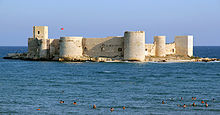Corycus
 Fortress of Corycus | |
| Location | Mersin Province, Turkey |
|---|---|
| Coordinates | 36°27′55″N 34°9′15″E / 36.46528°N 34.15417°E |

Corycus (
The city
Corycus was controlled by the Byzantine Empire.[1] Justinian I restored the public baths and a hospital. The admiral Eustathios Kymineianos re-fortified the island on the orders of Alexios I Komnenos at the beginning of the 12th century, adding a supplementary castle on a small island. This castle was later called "maidens castle", because it was told that a king held his daughter here in captivity until she was killed by a venomous snake. It was prophesied she would die by a snake bite. So she was taken to the sea castle to protect her, but a serpent was taken by basket to the castle, she was bitten and died. Corycus was conquered by the Armenians soon after it was rebuilt by the Byzantines.
Until the mid-14th century the Armenians held both the mainland and island castles, which guarded this strategic port for the
Archaeological surveys published in 1982 and 1987 found that the Armenians maintained (with occasional repairs) the

The ruins of the city are extensive. Among them are a triumphal arch, a
Bishopric
The city figures in the
Two Armenian inscriptions that were discovered at the castles of Korykos were credited to its construction to
Corycian Cave
In the Corycian Cave (now Cennet ve Cehennem), 20 stadia inland, says Strabo, the best crocus (saffron) grows. He describes this cave as a great hollow, of a circular form, surrounded by a margin of rock, on all sides of a considerable height; on descending into this cavity, the ground is found to be uneven and generally rocky, and it is filled with shrubs, both evergreen and cultivated; in some parts the saffron is cultivated: there is also a cave here which contains a large source, which pours forth a river of pure, pellucid water, but it immediately sinks into the earth, and flowing underground enters the sea: they call it the Bitter Water. Pomponius Mela (i.13) has a long description of the same place apparently from the same authority that Strabo followed, but more embellished. This place is probably on the top of the mountain above Corycus.
This place is famed in Greek mythology. It is the Cilician cave of Pindar (Pythian Ode i. 31), and of Aeschylus (Prom. Vinct. 350), and it is the lair of Zeus' fiercest opponent, the monster Typhon or Typhoeus.
See also
- Kızkalesi, Mersin(current settlement)
Gallery
-
Land castle of Korykos Southwest front
-
Land castle of Korykos Southwest and southeast front
-
Land castle of Korykos Southwest and southeast front
-
Land castle of Korykos View from necropolis across the road
-
Land castle of Korykos Northwest front
-
Land castle of Korykos Northeast side
-
Land castle of Korykos Channel along Northeast side
-
Land castle of Korykos Spolia
-
Land castle of Korykos View northeast with possible harbour entrance
-
Land castle of Korykos Channel along Northeast side
-
Land castle of Korykos Southeast side
-
Land castle of Korykos Southeast front
-
Land castle of Korykos Inside southeast walls
-
Land castle of Korykos Interior looking northeast
-
Land castle of Korykos Interior
-
Korykon Soldier's grave
-
Korykon Necropolis and castles
-
Korykon Sarcophagus
-
Korykon Sarcophagi and church
-
Korykon Church
-
Korykon Church
-
Korykon Church
-
Korykon Church
-
Korykon Church
-
Korykon Church
-
Korykon Church
References
- ISBN 978-0-8028-9017-7.)
{{cite book}}: CS1 maint: multiple names: authors list (link - ISBN 0-88402-163-7.
- ^ Edwards, Robert W., “Ecclesiastical Architecture in the Fortifications of Armenian Cilicia: First Report, Dumbarton Oaks Papers 36, 1982, pp.173-75, pls.38-42.
- ^ Siméon Vailhé, "Corycus" in Catholic Encyclopedia (New York 1908)
- ^ John Fulton, Index Canonum: The Greek Text, an English Translation, and a Complete Digest of the Entire Code of Canon Law of the Undivided Primitive Church (Wipf and Stock Publishers, 16 Sep 2014 page 151.
- ^ Michel Lequien, Oriens christianus in quatuor Patriarchatus digestus, Paris 1740, Vol. II, coll. 879-882
- ^ Pius Bonifacius Gams, Series episcoporum Ecclesiae Catholicae, Leipzig 1931, p. 435
- ^ Konrad Eubel, Hierarchia Catholica Medii Aevi, vol. 1 Archived 2019-07-09 at the Wayback Machine, p. 210; vol. 6, pp. 184–185
- ^ H. Rudt de Collenberg Wipertus, Le royaume et l'Église de Chypre face au Grand Schisme (1378-1417) d'après les Registres des Archives du Vatican, in Mélanges de l'École française de Rome, t. 94, n° 2, 1982, pp. 638 e 652
- ISBN 978-88-209-9070-1), p. 874
- ^ Langlois, op. cit (supra, note 21), 48.
- Smith, William (editor); Dictionary of Greek and Roman Geography, "Corycus", London, (1854)
- Blue Guide, Turkey, The Aegean and Mediterranean Coasts (ISBN 0-393-30489-2), pp. 550–51.
External links
- Kizkalesi photo gallery
- Corycus Castle photo gallery
- Corycus Church Ruins photos Archived 2021-06-21 at the Wayback Machine
- Carefully documented photographic survey and plans of Corycus Land and Sea Castles
- Corycus drone view and aerial shots
- About Corycus castle
 This article incorporates text from a publication now in the public domain: Smith, William, ed. (1854–1857). "Corycus". Dictionary of Greek and Roman Geography. London: John Murray.
This article incorporates text from a publication now in the public domain: Smith, William, ed. (1854–1857). "Corycus". Dictionary of Greek and Roman Geography. London: John Murray.
























